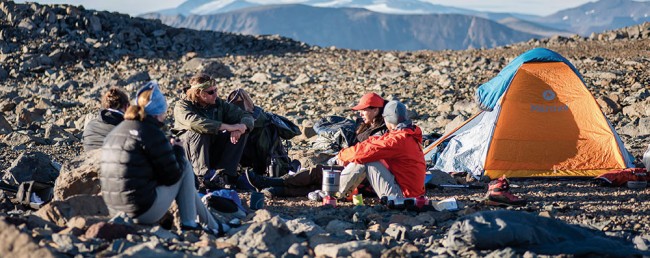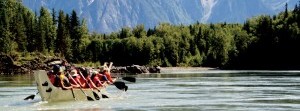
Photo Credit: Eric Saczuk/Space Hog Graphics
Leadership Development on the Land
It was more than a decade ago that I was backpacking in the remote and isolated Spatsizi in the heat of the day and the weight of the pack was taking its toll. My mind drifted off to another place and out of the corner of my eye I saw the outline of a person standing behind a tree; when I glanced over he was gone. I wondered, Was he even there or was it only in my mind?
When I am on the land I feel the presence of my ancestors, a feeling of being watched; it isn’t an eerie feeling, but one of comfort. I have learned to accept these encounters and their presence even though my rational mind cannot explain them. My understanding of the events is through Tahltan stories about creation and respect, which help guide my understanding of who I am.
The land can teach about aboriginal and geological history; it tells us how it was formed. Science tells similar stories by explaining the physical forces of creation, while aboriginal stories explain the spiritual forces. Knowing both means you get a more complete picture about what is happening on the land.
It was with this teaching in mind that I developed the Tahltan Outdoor Leadership Program in 2005 to expose youth to Tahltan culture and identity. Over five years, 25 Tahltan youth each backpacked an average 31.2 km for a grand total of 780 km, which is equivalent to the distance from Dease Lake to Burns Lake. One attended four campouts and backpacked a total of 78 km.
I watched young teens gradually mature into young adults who helped with the camp chores and took on leadership roles. They became more confident in who they were as Tahltans. Some took an interest in Tahltan stories and engaged in deep conversations about what the stories meant to them. Others became interested in nature and explored stream banks, flowers along the trail and abandoned beaver lodges; some provoked learning by asking each other questions about what they were seeing and sharing knowledge about nature.
The element of risk helps create an atmosphere of teamwork and cooperation. It allowed the youth to open up and show who they were with less fear of backlash because they were all in an unfamiliar environment that required more cooperation.
Identity formed from the earth
Tahltan territory contains the Stikine River and its headwaters. It is huge—about 11 percent of BC— and is the highlands of northwestern North America, as the region’s two major river systems originate here: the Yukon and Mackenzie. It is also the headwaters of the Taku, Nass, Skeena and Stikine rivers. This land is the crossroads of the drainages to the Arctic and Pacific oceans and the Bering Sea. No other place in Canada has this diversity of watersheds.
The Tahltan have lived on this land since time immemorial and this has created a unique culture that continues to inform our Tahltan identity. When youth are on the land they learn outdoor skills, leadership and cultural practices. Their knowledge of place names supports their understanding of their experiences. The stories are the voices of our ancestors, which present life from an aboriginal perspective.
Tsesk’iya Cho Ts’eseledzi (Raven Big Pee Down) is a bluff above the Stikine River along the Telegraph Creek Road; the bluff has long white streaks from top to bottom. When Tsesk’iya Cho was in Tahltan Territory a long time ago, he used this rock as his bathroom, hence the name. Tsesk’iya Cho also had a house, Tsesk’iya Cho Kimme (Raven Big House): the bluff with a large raven’s wingspan commonly mistaken as Eagle Rock on the south side of the Stikine River across from the confluence with the Tahltan River. He would fly across the river from his house to use his bathroom.
Not long ago, the Ministry of Transportation widened the Telegraph Creek Road and blasted the bluff. In the explosion, a sculpture of a raven was formed, which can be seen when you travel to Telegraph Creek. Tsesk’iya Cho laid claim to his old pee-down spot. This shows that our stories about Tsesk’iya Cho are continuing even today, in the now, and that creation is ongoing. It allows Tahltan to see our stories and hear the voices of our ancestors in our stories.
What better way to learn?
From my experiences on the land, I envision ways to affect social change in aboriginal youth so they don’t travel down unhealthy roads in life with the same misunderstandings about our collective experience of colonization. From other communities, academics, First Nations and elders, I have learned best practices for aboriginal well-being. My approach, like so many others, is from the land because that is where our culture originates.
It’s been shown that culturally based programs on the land protect against risky behaviour. In a presentation by Michael Chandler to the Assembly of First Nations National Policy Forum in 2005, the UBC professor linked communities bearing “cultural continuity factors” with low to non-existent suicide rates. Forty percent of bands in Canada between 1987 and 2000 and one in five tribal councils had no recorded deaths by suicide. Half the bands surveyed had youth suicide rates lower than the general population, making it incorrect to say that all First Nations have high suicide rates. The authors of the survey conclude that preserving a sense of personal and cultural persistence are factors present in bands and tribal councils with low youth-suicide rates.
Healing trauma on the land
We have all experienced some level of psychological trauma—an injury to the brain as a result of stress from bullying, harassment, discrimination or family violence. Recent studies involving mice indicate that trauma can be inherited from ancestors. If this is possible, it raises questions regarding the intergenerational impacts to aboriginal people from colonization.
Being on the land has elements of risk and when those who have suffered trauma successfully experience an outdoor adventure, it can aid in resolving past trauma as an incidental by-product without having to re-visit the event.
An additional benefit of the Tahltan Outdoor Leadership Program is the ability to empower people to make change and assert their rights. The goal is to provide leadership skills and knowledge about networking and connecting to other change agents and resources. This empowers youth to make social change through personal and community development and de-colonization.
All this cannot take place unless people have a strong sense of identity: they must know who they are. One’s inner soul has been described as the “abyss” and the task of peering into it can be daunting; it is for me. All youth today have even more pressure to conform to the images of the super athlete, super model and super star by pop culture standards. Experiences on the land allow youth to get away from these pressures and gain the space to discover their own true essence. The land has the potential to teach those who respect it and who pay attention to what it has to offer.






